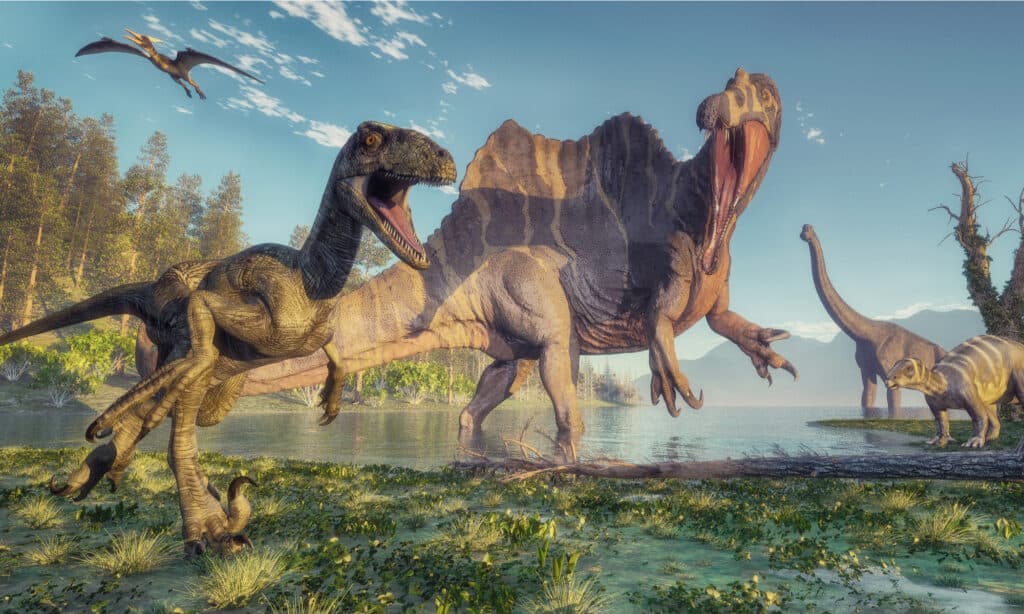Spinosaurus
†Spinosaurus aegyptiacus
The Spinosaurus is the biggest carnivorous dinosaur ever discovered!
Advertisement
Spinosaurus Scientific Classification
- Kingdom
- Animalia
- Phylum
- Chordata
- Order
- Saurischia
- Family
- †Spinosauridae
- Genus
- †Spinosaurus
- Scientific Name
- †Spinosaurus aegyptiacus
Read our Complete Guide to Classification of Animals.
Spinosaurus Conservation Status
Spinosaurus Facts
- Prey
- Giant Coelacanths, sawfish, large lungfish, sharks and Cretaceous pterosaur
- Main Prey
- Fish
- Group Behavior
- Solitary except during mating season
- Fun Fact
- The Spinosaurus is the biggest carnivorous dinosaur ever discovered!
- Most Distinctive Feature
- It's sail
- Distinctive Feature
- Crocodile-shaped head
- Temperament
- Aggressive
- Habitat
- North Africa, England, Spain, Portugal, China, Thailand, Brazil
- Diet
- Carnivore
- Lifestyle
- Solitary
- Favorite Food
- Fish
- Common Name
- Spinosaurus
- Number Of Species
- 3
- Location
- North Africa, England, Spain, Portugal, China, Thailand, Brazil
View all of the Spinosaurus images!
A Spinosaurus lived around 90-100 million years ago during the Cretaceous period.
Their fossils were first discovered in Egypt by the Bavarian paleontologist Freiherr Ernst Stromer in 1912. It’s considered the largest known carnivore ever discovered and could reach lengths of 60 ft., which is the same size as a bowling lane or four cars parked behind each other.
Spinosaurus means “spine lizard” because of the sail (fin) on its back. Paleontologists have different theories about the fin’s function and much more, as not much is known about this gigantic dinosaur.
Incredible Spinosaurus Facts!
- Spinosaurus is the biggest carnivorous dinosaur ever found
- Scientists believe that the Spinosaurus mainly lived in water
- The first Spinosaurus fossils ever found were destroyed during World War II
Description & Size
Spinosaurus is most notably known for its sail which was made up of protruding spinal spikes on its back. Their long, narrow skulls housed sharp teeth that resemble the modern-day crocodile. Other characteristics include:
- Weighed up to 31,000lbs
- Height of 23ft
- Length between 45 to 60 feet
Their bite power measures 19,000 Newtons, and their huge crocodile-like jaws contained 64 conical teeth.
Theories About the Sail’s Function
Paleontologists have disagreed about the function of the fin on the Spinosaurus’s back. However, there are a few interesting theories worth considering.
Theory One
It might have acted as a form of protection. This theory may be a bit far-fetched because the Spinosaurus had no known threats or predators because of its size. However, scientists believe that when fully extended, the sail made them appear much larger, and as they were so big as is, this was extremely intimidating.
In addition, there is a possibility they used it to attract a mate. There is significant evidence that their spines were flexible, making it easy to arch their backs.
Theory Two
A second theory is that they used their sails to regulate their body temperature by storing any access fat or absorbing heat. Unfortunately, this theory is even less likely as their sails were made from bones with minimal blood vessels encased in tight skin.
Theory Three
The last theory is the fins were a bright color, similar to modern-day reptiles or amphibians. So, highlighting this massive structure with bright colors makes it a hard-to-ignore display structure.
However, it is possible that the fin had more than one function.

©Orla/Shutterstock.com
Diet – What Did the Spinosaurus Eat?
The Spinosaurus was a carnivore, but it preferred eating fish. Some of the species it preyed on were:
Some paleontologists believe that the Spinosaurus hunted in water because of its fin-like tail and webbed feet, which looked like large paddles.
There is a good chance that when it was on dry land, it walked on its two hind legs. This is due to the Spinosaurus’s long neck and trunk; it’s likely it had a forward-leaning center of gravity.
Habitat – When and Where It Lived
The Spinosaurus was first discovered in Egypt, but many researchers believe it originated in Western Europe. After the continents started to split, they migrated down to North Africa. Other countries where fossils were found include:
The Spinosaurus lived 90 to 100 million years ago during the Cretaceous Period and preferred swampy areas where they had abundant fish to eat.
Many paleontologists believe that the Spinosaurus spent the majority of its time in the water. Just like the early whales and other aquatic species, the Spinosaurus had:
- Short hind legs and dense bones to help weigh it down in the water
- Flat and wide claws and feet
- A long snout similar to a crocodile
- Conical teeth, which are an advantage for catching fish
- Fin-like tail
Threats and Predators
The adult Spinosaurus was the largest carnivore of its time, making it unlikely to have many threats. However, their young developed in eggs and were probably the size of a small dog when hatching. So, it is probable that they were preyed on by predators in the area.
For example, the specimens found in North Africa likely had to protect their young from:
- Ancient crocodiles
- Pterosaurs
- Big fish
- Sharks
In addition, while still in the egg, they were vulnerable to:
Discoveries and Fossils – Where It was Found
A Bavarian paleontologist called Freiherr Ernst Stromer made a life-changing discovery in 1912. He discovered an unknown dinosaur with a gigantic jaw and five-foot spines, signaling that it had a sail or hump. He named it the Egyptian Spine Lizard, which translates into Spinosaurus.
However, the remains were destroyed by a Nazi supporter in 1944 during World War II because Stromer spoke out in public and criticized the Nazi party. So, unfortunately, the only surviving evidence is the detailed drawings and descriptions archived in Germany.
Other discoveries include:
The largest amount of Spinosaurus fossils was found in a cave outside Erfoud, Morrocco. With these bones, paleontologists finally had enough information to create the most defined Spinosaurus picture ever.
Extinction – When Did It Die Out?
The Spinosaurus roamed this earth during the Cenomanian and Albain ages over 90 million years ago. They died out 30 million years before the T-Rex showed up.
There’s a debate about how they perished. Some paleontologists believe a flood wiped them out, while others say it was a drought.
Similar Animals to the Spinosaurus
As the Spinosaurus is thought to be the largest terrestrial carnivore ever to roam the earth, there is not much that can compare. However, there were a few theropods that came close:
- Tyrannosaurus – A monstrous dinosaur weighing up to eight tons and stretched over 40ft. Their jaws were so powerful they could crush a car.
- Giganotosaurus – Discovered in Argentina and Patagonia, this terrifying giant weighed 7-8 tons and measured 40-43ft in length. It was the first discovery of a dinosaur that could match the T-Rex.
- Carcharodontosaurus – Named after the great white shark (Carcharodon) because of the similarities between their teeth. It matched, if not exceeded, the size of the T-Rex and Giganotosaurus.
Significance in Today’s Culture
The Spinosaurus made its debut in Jurassic Park III in 2001. It took center stage by killing the T-Rex within seconds by snapping its neck.
We next see the Spinosaurus in Jurassic World, where the T-Rex saves the day by crashing through a skeleton, culminating in an epic fight with the Spinosaurus.
In Jurassic World: Camp Cretaceous, we see a familiar antagonist return to our screens; the spinosaurus from the third movie.
Besides the films, they are making appearances in:
- Action figures
- Video games
- Books
In addition, Angola, Gambia, and Tanzania have honored this prehistoric beast by putting it on their postage stamps.
View all 293 animals that start with SSpinosaurus FAQs (Frequently Asked Questions)
When was the Spinosaurus Alive?
During the Cretaceous Period over 90-100 million years ago.
How big was Spinosaurus?
They could weigh up to 31,000 pounds and reach lengths of 40 to 60 feet.
What did the Spinosaurus eat?
Primarily fish like Gaint coelacanths, sawfish, large lungfish, and sharks.
When did the Spinosaurus go extinct?
The Spinosaurus roamed this earth during the Cenomanian and Albain ages over 90 million years ago. They died out 30 million years before the T-Rex showed up.
Is the Spinosaurus bigger than a T-Rex?
Yes, the Spinosaurus is the largest known terrestrial carnivore to ever be discovered.
What is unique about the Spinosaurus?
The Spinosaurus is thought to have lived primarily in water, patrolling the rivers of North Africa.
What is the closest animal to a Spinosaurus?
As the Spinosaurus is thought to be the largest terrestrial carnivore ever to roam the earth, there is not much that can compare. Still, the Tyrannosaurus, Gigantosaurus, and Carcharodontosaurus came close.
Was Spinosaurus bigger than Giganotosaurus?
Until new estimates come out, Spinosaurus is likely the largest carnivore to have ever walked on earth. It is bigger than Gigantosaurus.
Thank you for reading! Have some feedback for us? Contact the AZ Animals editorial team.
Sources
- Wikipedia, Available here: https://en.wikipedia.org/wiki/Spinosaurus#Description
- Britannica, Available here: https://www.britannica.com/animal/saurischian
- The Dinosaur Database, Available here: https://dinosaurpictures.org/Spinosaurus-pictures
- Fossil Guy, Available here: https://www.fossilguy.com/gallery/vert/dinosaur/spinosaurus/index.htm
- a-z-animals, Available here: https://a-z-animals.com/blog/t-rex-vs-spinosaurus-who-would-win-in-a-fight/#:~:text=It%20could%20run%20at%2017mph,was%20far%20better%20at%20swimming.
- Live Science, Available here: https://www.livescience.com/24120-spinosaurus.html
- Prehistoric Wildlife, Available here: http://www.prehistoric-wildlife.com/species/s/spinosaurus.html

















